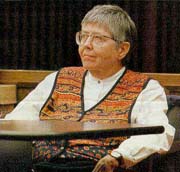
Mary Daly has always been a philosopher for the people. Since the beginning of her career, she has been concerned with giving her readers and students tools with which to understand the nature of patriarchy. She enabled a wide variety of women and men to understand issues of sexism in ontological terms with her widely read Beyond God the Father. Her subsequent works have built upon, revised and expanded her interpretation of ultimate reality. Using metaphors and word-plays as devices to communicate her perspective, she teaches her position to her readers. Her genius is not only in her astute observations, but also in her methods of communication.
Mary Daly is now, as she has always been, a controversial figure. Beyond being a feminist icon, Daly is also a scholar of substantial achievement and the author of seven books and countless articles and lectures. She received her first Ph.D. in religion at the at Saint Mary's College in Notre Dame, Indiana. Unable to pursue a Ph.D. in Catholic theology in the United States, she pursued her studies in Switzerland at the University of Fribourg. Her intellectual curiosity and tenacity made it possible for her to be the first woman to receive the highest degree in Sacred Theology possible, and with highest honors (summa cum laude). She remained in Fribourg to receive her third Ph.D. in Philosophy. When she returned to the United States, she took an appointment as an Assistant Professor at Boston College.
In response to the publishing of her first book The Church and the Second Sex in 1969, Mary Daly was issued a terminal contract by Boston College i.e. her position would not be renewed once it had expired. Her situation became the cause for student protests, petitions, and teach-ins celebrating academic freedom. With student (all male at the time) and other popular support, not only was she taken on as full professor but also was given tenure. Now, in the year two thousand (archaic deadtime, in Daly's terms), she is yet again the subject to dismissal from the college where she has taught for the last twenty five years as a tenured professor. At this time, when Mary Daly is under attack and rigorous feminist debate is at a nadir in popular discourse, revisiting and reviving the work of Daly and others like her seems appropriate if not important.
As a scholar and an activist, Daly has been on the forefront of feminist theory. Not surprisingly, she took the step into hyper-communication without necessarily being aware of the implications. Her 1987 parody of patriarchal dictionaries, the Websters’ First New Intergalactic Wickedary of the English Language (Wickedary), is a document written in hypertext. It may be confined to the printed page, but with its bits of information cross-referenced, coded and annotated, its text occupies an intellectual space rather than a flat page. It clearly fits the definition given to hypertext by Theodor Holm Nelson, the inventor of the term. When he discusses hypertext, and by extension hypermedia, he simply means "non-sequential writing — text that branches and allows choices to the reader." (Nelson 1992) This definition and the Wickedary’s relationship to it are crucial to the understanding of its visionary nature.
With the Wickedary, Mary Daly positions herself among writers who have rejected the confines of the linear argument (or narrative) and the printed page. The Wickedary allows the reader to freely navigate terms and concepts from her other books. She gives the readers connections to follow at their discretion and gives them notes that expand her text into other writers’ works, making connections to the larger feminist community and an intellectual heritage. This step into hyper-space, while unfulfilled in the digital sense, fulfills her own demand for "Weaving" by "Websters," "Lusty Leaping," "Journeying" and occupying the "Otherworld."